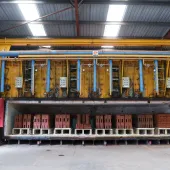Mitigating the financial impact of red diesel reform

Paul Dekker Kleyn outlines the benefits of the dual-fuel Hydrogen-Diesel Introduction System
SPECIALIZING in alternative power drivers, Prior Power Solutions’ business development manager, Paul Dekker Kleyn, explains how businesses can lessen the financial impact of the impending changes to red diesel, whilst simultaneously reducing carbon emissions:
‘To non-users, red diesel is probably thought of as a rebated fuel mainly used by farmers. In fact, red diesel been used for decades by a wide range of industries, including construction, mining, quarrying, oil and gas extraction, leisure, airport, and port operations for off-road machinery and vehicles, in addition to back-up power generation.
‘Red diesel accounts for around 15% of all diesel used in the UK and for around 14 million tonnes of carbon dioxide emissions each year. It is the same as regular diesel, but with a red dye added to prevent it being used by non-exempt applications – particularly road users.
‘The introduction of red dye and chemical markers to distinguish between rebated and non-rebated diesel was brought in in 1961, although a reduced rate for ‘off-road’ vehicles had been used since 1935. Over the years, the list of exempt vehicles and applications has been extended, however the reform due to come in next month is the biggest shake up in its history.
‘From 1 April 2022, red diesel will not be available to many who have benefited from it over the last nine decades, and with the cost of diesel at record levels, the difference to businesses and their bottom line will be hugely costly at best, detrimental at worst.
‘However, there is an option on the market right now that can reduce the fuel consumption of diesel engines and diesel generators by up to 14%. Retrofittable to existing and new diesel engines, the Hydrogen-Diesel Introduction System effectively converts a standard combustion engine into a dual-fuel engine. It’s a stand-alone system that produces hydrogen gas from water by electrolysis, which is injected directly into the engine, reducing fuel consumption as well as harmful emissions.
‘While sceptics might be nervous about hydrogen technology, the system is completely safe, as no hydrogen is stored. Although there is nothing to suggest hydrogen fuel vehicles are in any way dangerous, this is completely different technology.
‘Take a genset application with a 15.2-litre engine running a conservative 200 hours a month. If that engine has been powering a rebated application running on red diesel at 69 pence per litre, that’s some £97,704 fuel each year. If, from 1 April, that engine runs on regular diesel at a conservative and perhaps optimistic £1.27 per litre, the annual fuel cost will be £179,832.
‘Add a Hydrogen-Diesel Introduction System, the capital cost of which amortized over five years, the small amount of water required, annual service and cell replacement after 8,000-10,000 hours, the system on that one engine will save a conservative £10,685 of fuel each year, and that’s based on a modest 10% fuel saving.
‘Many operators with the latest Hydrogen-Diesel Introduction System technology are reporting an even greater yearly return on fuel savings than this. And the savings become even more impressive when you look at installing the unit on a fleet of diesel generators.
‘Also, when a business-changing price hike comes in, it can be hard to prioritize the environment, but the Hydrogen-Diesel Introduction System also dramatically reduces greenhouse gases. Independent testing has proven up to 80% less diesel particulate matter, 22% less nitrous oxides, 25% less carbon monoxide, and 8% less carbon dioxide. Using the example above, a single Hydrogen-Diesel Introduction System unit would save 37 tonnes of carbon dioxide per year (equivalent to 10,064kg of carbon).
‘Whilst the development of hydrogen-powered vehicles is exciting, and certainly one of the ways toward achieving net zero, there are hundreds of thousands of diesel engines and generators operating daily. To replace all of these with hydrogen-powered internal combustion engines would take many years.
‘However, the Hydrogen-Diesel Introduction System, whilst not omitting diesel completely, does provide a very cost-effective and realistic option in the interim for reducing diesel consumption and environmental impact. And with the price of diesel rising daily, mounting concern about security and ethics of supply, why wouldn’t you want to look at mitigating these risks through a simple dual-fuel solution.’









